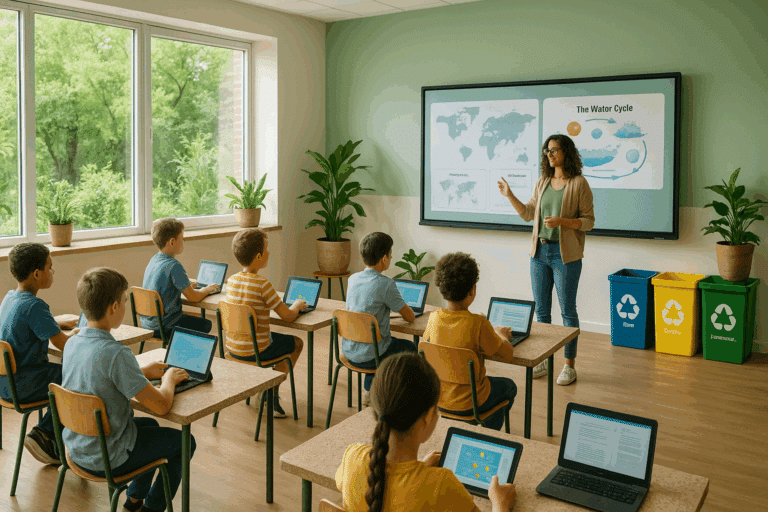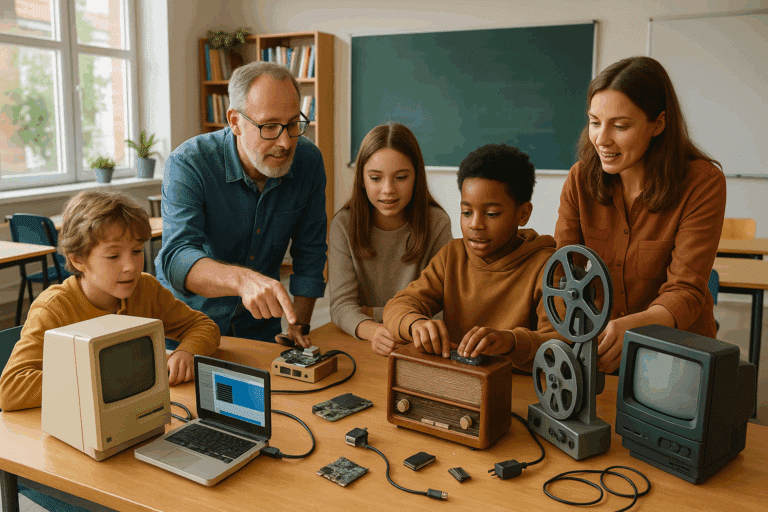Anúncios
Welcome to the world of eco-friendly virtual gatherings and webinars, an innovative approach to hosting events that not only takes advantage of technological advancements but also champions environmental responsibility.
These digital meetups, spanning from small-scale group discussions to large webinars, carry with them the potential to redefine how we interact with our peers, colleagues, and clients. More importantly, they present an opportunity to host events that resonate with an increasingly eco-conscious audience and foster a culture of sustainability in the digital landscape.
Why Should We Consider Eco-friendly Virtual Gatherings?
Before diving into the intricacies of hosting green events and webinars, it’s important to understand why they’re growing in popularity and importance. The compelling intersection of technology, communication, and environmental responsibility has led to a dramatic shift in the way we conceive and conduct events. Green initiatives aren’t just a trend anymore – they’re a necessary aspect of our global community’s efforts to combat climate change. Eco-friendly virtual gatherings are at the forefront of these efforts.
What’s In Store For You?
By the end of this comprehensive guide, you’ll be armed with all the necessary knowledge and tools to host your own eco-friendly virtual gathering or webinar. We’ll delve into the nuts and bolts of eco-friendly hosting, from selecting the right virtual platform and designing an engaging digital experience to promoting your event and keeping your audience engaged.
The Eco-friendly Advantage
The environmental benefits of virtual gatherings are evident – reduced travel means lower carbon emissions, less waste from event materials, and a significant decrease in energy consumption. But the advantages don’t stop there. Eco-friendly virtual gatherings offer numerous benefits beyond the environmental. They are cost-effective, scalable, and accessible, opening up new avenues for audience engagement and business growth.
Overcoming Challenges and Maximizing Potential
However, like any paradigm shift, the transition to eco-friendly virtual gatherings comes with its own set of challenges. Understanding and overcoming these hurdles is a crucial part of the journey. We’ll explore strategies for addressing common obstacles like technology issues, participant engagement, and creating a sense of community in a digital environment.
Key Takeaways
So, whether you’re an experienced event organizer looking to transition to more sustainable practices, or a newbie trying to figure out how to host your first webinar, this guide will provide practical, step-by-step guidance to help you navigate the world of eco-friendly virtual gatherings. We’ll share valuable insights, tips, and best practices gleaned from industry experts, as well as real-life case studies, to help you understand and harness the power of green events and webinars.
Let’s embark on this journey to make our digital interactions more sustainable, one eco-friendly virtual gathering at a time.
Understanding the Need for Eco-Friendly Virtual Gatherings
As we navigate through the digital age, the need to reduce our carbon footprint and embrace eco-friendly practices has never been more crucial. With the rise of virtual gatherings, from webinars to online meetings, we have a unique opportunity to host green events that limit waste and conserve resources. This approach not only benefits the environment but also promotes a sustainable culture within communities and organizations.
Notably, hosting an eco-friendly virtual gathering requires careful planning and a deep understanding of green principles. It’s not simply about turning off the lights or reducing paper waste; it involves a comprehensive approach that intertwines technology, user behavior, and sustainability practices.
Video Title: “How to Host a Green Webinar: Tips and Best Practices” – Green Tech Solutions YouTube Channel.
The Impact of Virtual Gatherings on the Environment
Despite the clear reduction in travel-related emissions, virtual gatherings are not entirely carbon-neutral. The energy consumption involved in powering data centers, transmitting data over networks, and running devices can add up to a significant environmental footprint. Therefore, understanding these impacts is the first step in optimizing your virtual gatherings for eco-friendliness.
Planning for an Eco-Friendly Virtual Gathering
Successful planning for a green virtual event revolves around three core elements: the platform, the content, and participant behavior. Each of these aspects plays a crucial role in determining the overall environmental impact of your gathering.
When choosing a platform, consider factors such as energy efficiency and data usage. Platforms that require high bandwidth or use energy-inefficient servers contribute to higher carbon emissions. Likewise, your content should be designed with sustainability in mind. This includes using eco-friendly design elements and promoting green practices during the event. Lastly, encouraging participants to engage in eco-friendly behaviors, such as using energy-efficient devices or powering off their devices when not in use, can further reduce the environmental footprint of your gathering.
Table Title: Comparison of Energy Efficiency and Data Usage of Popular Virtual Gathering Platforms. (Please refer to the table below)
Anúncios
Platform
Energy Efficiency
Data Usage
Zoom
High
Medium
Skype
Medium
High
Google Meet
High
Low
Anúncios
Microsoft Teams
Low
High
Engaging Participants in Eco-Friendly Practices
A green virtual gathering is only as successful as its participants make it. Encouraging attendees to adopt eco-friendly behaviors can significantly enhance the sustainability of your event. This can be achieved by providing tips on energy-saving practices, such as adjusting screen brightness, closing unused apps, and using energy-efficient hardware.
Additionally, consider sending digital reminders about the event instead of traditional paper invitations, and use e-certificates or digital badges instead of physical rewards or acknowledgments. Every small step towards reducing waste and conserving energy counts.
Video Title: “10 Easy Ways to Save Energy During Virtual Meetings” – Eco Warrior YouTube Channel.
Implementing Eco-Friendly Features in Your Virtual Gatherings
Incorporating eco-friendly features into your virtual gatherings can enhance their sustainability and provide an engaging experience for attendees. This could include features like a ‘green room’ where participants can learn about sustainability practices, or an ‘energy tracker’ that displays the energy consumption of the event in real-time. Such features not only promote environmental consciousness but also add a unique element to your gathering.
Enhancing the Sustainability of Your Virtual Gatherings
While implementing eco-friendly practices is a significant step forward, continuous improvement is essential for long-term sustainability. Regularly assess the environmental impact of your virtual gatherings and seek ways to improve. Use the feedback from attendees and the data from your events to identify areas of improvement and implement changes.
A commitment to sustainability is not a one-time act, but a continuous process of learning, implementing, and improving. With careful planning and a dedicated approach, your virtual gatherings can become a powerful tool for promoting sustainability and eco-friendliness.
Video Title: “Sustainable Event Management: Best Practices for Virtual Gatherings” – Eco Event Planner YouTube Channel.
ConclusionIn conclusion, we have traversed a significant spectrum of technical insights in this article. We have dissected, analyzed, and discussed some of the most complex concepts in the field of Information Technology (IT) and Software Engineering. The importance of such a comprehensive understanding cannot be overstated. We live in a world driven by technology, where those with the ability to comprehend and manipulate it have the edge.
Our journey began by exploring the intricacies of software development, highlighting its core aspects such as planning, coding, testing, and maintenance. It’s not just about writing code; it’s about the strategic approach to solving problems and building a functional and efficient system (source).
We then delved into the world of algorithms and data structures. An algorithm is a step-by-step procedure to solve a particular problem, while data structures are the building blocks for data organization and management. A deep understanding of these elements is crucial in the world of programming (source).
Moving on, we discussed the principles of database management systems (DBMS). DBMS are software applications that interact with the user, applications, and the database to capture and analyze data. They are a crucial component of IT infrastructure, enabling the efficient handling of vast amounts of data (source).
Network security, an essential aspect of our interconnected world, was another topic that we examined in depth. We highlighted the importance of understanding network vulnerabilities and implementing security measures to prevent data breaches and other cyber threats (source).
The goal was not just to provide you with a bird’s-eye view but to dive deep into the details, offering you a comprehensive perspective on each of these subjects. A technical understanding is crucial, but it needs to be accompanied by the ability to apply this knowledge in real-world scenarios.
Having said that, learning is an ongoing process, and we invite you to explore these topics further. Do share your thoughts and experiences as they could potentially be invaluable to others in the community. Also, feel free to share this article with others who might find it helpful.
In this era of digital transformation, we all have a role to play in shaping the future. Your expertise and contributions in the field of IT and software engineering can make a significant difference. Remember, “The science of today is the technology of tomorrow” (Edward Teller). So, let’s keep learning, sharing, and innovating together.
Thank you for spending your time with us, and we look forward to bringing you more insightful articles. Stay curious, stay informed, and keep moving forward. Let’s continue to bridge the gap between complexity and understanding, one article at a time.
Keep exploring, keep innovating, and most importantly, keep learning!



